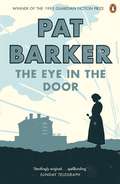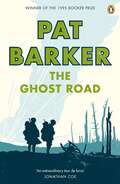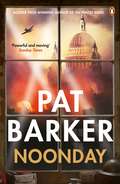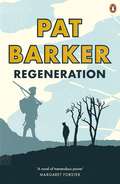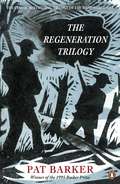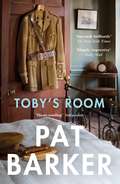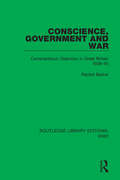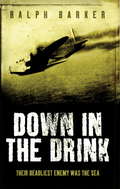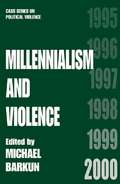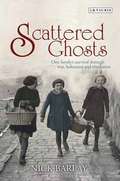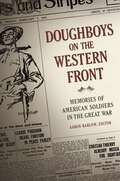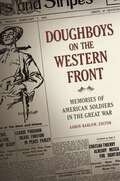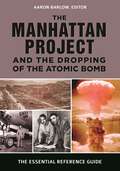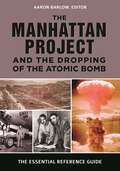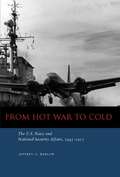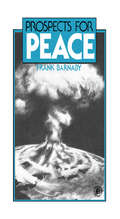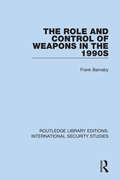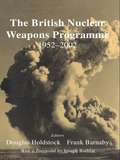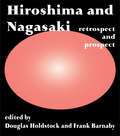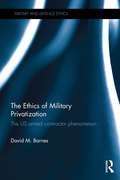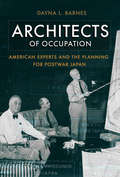- Table View
- List View
The Eye in the Door: The Second Volume Of The Regeneration Trilogy (Regeneration #2)
by Pat BarkerThe Eye in the Door is the second novel in Pat Barker's classic Regeneration trilogy.WINNER OF THE 1993 GUARDIAN FICTION PRIZE.London, 1918. Billy Prior is working for Intelligence in the Ministry of Munitions. But his private encounters with women and men - pacifists, objectors, homosexuals - conflict with his duties as a soldier, and it is not long before his sense of himself fragments and breaks down. Forced to consult the man who helped him before - army psychiatrist William Rivers - Prior must confront his inability to be the dutiful soldier his superiors wish him to be ...The Eye in the Door is a heart-rending study of the contradictions of war and of those forced to live through it.'A new vision of what the First World War did to human beings, male and female, soldiers and civilians'A. S. Byatt, Daily Telegraph'Every bit as waveringly intense and intelligent as its predecessor'Sunday Times'Startlingly original . . . spellbinding'Sunday Telegraph'Gripping, moving, profoundly intelligent . . . bursting with energy and darkly funny' Independent on SundayOther titles in the trilogy:RegenerationThe Ghost Road
The Ghost Road (Regeneration #3)
by Pat BarkerThe Ghost Road is the final instalment in Pat Barker's Regeneration trilogy.WINNER OF THE 1995 BOOKER PRIZE.1918, the closing months of the war. Army psychiatrist William Rivers is increasingly concerned for the men who have been in his care - particularly Billy Prior, who is about to return to combat in France with young poet Wilfred Owen. As Rivers tries to make sense of what, if anything, he has done to help these injured men, Prior and Owen await the final battles in a war that has decimated a generation ...The Ghost Road is the Booker Prize-winning account of the devastating final months of the First World War.'An extraordinary tour de force. I'm convinced that the trilogy will win recognition as one of the few real masterpieces of late twentieth-century British fiction' Jonathan Coe'Powerful, deeply moving' Barry Unsworth, Sunday Times'Harrowing, original, unforgettable' Independent'A triumph' Sunday TimesOther titles in the trilogy:RegenerationThe Eye in the Door
Noonday (Life Class Trilogy Ser. #3)
by Pat BarkerIn Noonday, Pat Barker - the Man Booker-winning author of the definitive WWI trilogy, Regeneration - turns for the first time to WWII.'Afterwards, it was the horses she remembered, galloping towards them out of the orange-streaked darkness, their manes and tails on fire...'London, the Blitz, autumn 1940. As the bombs fall on the blacked-out city, ambulance driver Elinor Brooke races from bomb sites to hospitals trying to save the lives of injured survivors, working alongside former friend Kit Neville, while her husband Paul works as an air-raid warden. Once fellow students at the Slade School of Fine Art, before the First World War destroyed the hopes of their generation, they now find themselves caught in another war, this time at home. As the bombing intensifies, the constant risk of death makes all three of them reach out for quick consolation. Old loves and obsessions re-surface until Elinor is brought face to face with an almost impossible choice.Completing the story of Elinor Brooke, Paul Tarrant and Kit Neville, begun with Life Class and continued withToby's Room, Noonday is both a stand-alone novel and the climax of a trilogy. Writing about the Second World War for the first time, Pat Barker brings the besieged and haunted city of London into electrifying life in her most powerful novel since the Regeneration trilogy.'Bold, hard-hitting, unforgettable... a virtuoso rendition of the bombing, as huge swathes of London blaze away with the brightest of bright lights... Barker shows us how the city's finest moment was indubitably also its most terrifying, with luminous and unsparing insight.' Independent on Sunday'Barker's command of detail and gift for metaphor are as sharp as ever... As a tribute to those who dared and suffered on the home front, Noonday is in the first rank.' Antony Garner, Mail on Sunday'Narrative jumps colourfully alive, fizzes with energy.' Michele Roberts, Independent'Tremendously good.' Daily Mail'Pat Barker's Noonday marked the end of another war trilogy which shows no end to her talent in describing how conflicts rupture the soul.' Arifa Akbar, IndependentPraise for Pat Barker:'She is not only a fine chronicler of war but of human nature.' Independent 'A brilliant stylist... Barker delves unflinchingly into the enduring mysteries of human motivation.' Sunday Telegraph'You go to her for plain truths, a driving storyline and a clear eye, steadily facing the history of our world.' The GuardianOther titles in the trilogy:Life ClassToby's Room
Regeneration (Regeneration #1)
by Pat BarkerA Hay Festival and The Poole VOTE 100 BOOKS for Women SelectionThe modern classic of contemporary war fiction - a Man Booker Prize-nominated examination of World War I and its deep legacy of human traumas.'A brilliant novel. Intense and subtle' Peter Kemp, Sunday TimesCraiglockhart War Hospital, Scotland, 1917, and army psychiatrist William Rivers is treating shell-shocked soldiers. Under his care are the poets Siegfried Sassoon and Wilfred Owen, as well as mute Billy Prior, who is only able to communicate by means of pencil and paper. Rivers's job is to make the men in his charge healthy enough to fight. Yet the closer he gets to mending his patients' minds the harder becomes every decision to send them back to the horrors of the front. Pat Barker's Regeneration is the classic exploration of how the traumas of war brutalised a generation of young men.This is the first novel in Pat Barker's Man Booker Prize-winning Regeneration Trilogy:I: RegenerationII: The Eye in the DoorIII: The Ghost Road'A vivid evocation of the agony of the First World War and a multi-layered exploration of all wars. A fine anthem for doomed youth' Time Out'A novel of tremendous power' Margaret Forster 'Unforgettable' Sunday Telegraph'One of the strongest and most interesting novelists of her generation' Guardian
The Regeneration Trilogy: Regeneration; The Eye In The Door; The Ghost Road (The\wwi Trilogy Ser. #1)
by Pat BarkerThe Regeneration Trilogy is Pat Barker's sweeping masterpiece of British historical fiction. 1917, Scotland. At Craiglockhart War Hospital in Scotland, army psychiatrist William Rivers treats shell-shocked soldiers before sending them back to the front. In his care are poets Siegfried Sassoon and Wilfred Owen, and Billy Prior, who is only able to communicate by means of pencil and paper. . .Regeneration, The Eye in the Door and The Ghost Road follow the stories of these men until the last months of the war. Widely acclaimed and admired, Pat Barker's Regeneration trilogy paints with moving detail the far-reaching consequences of a conflict which decimated a generation.'Harrowing, original, delicate and unforgettable' Independent'A new vision of what the First World War did to human beings, male and female, soldiers and civilians. Constantly surprising and formally superb' A. S. Byatt, Daily Telegraph'One of the few real masterpieces of late twentieth-century British fiction' Jonathan CoePat Barker was born in 1943. Her books include the highly acclaimed Regeneration trilogy, comprising Regeneration (1991); which was made into a film of the same name; The Eye in the Door (1993), which won the Guardian Fiction Prize; and The Ghost Road (1995), which won the Booker Prize, as well as the more recent novels Another World, Border Crossing, Double Vision, Life Class and Toby's Room. She lives in Durham.
Toby's Room (Life Class Trilogy Ser. #2)
by Pat BarkerToby's Room is the second novel in Pat Barker's Life Class Trilogy, returning to the First World War in a dark, compelling examination of human desire, wartime horror and the power of friendshipWhen Toby is reported 'Missing, Believed Killed', another secret casts a lengthening shadow over Elinor's world: how exactly did Toby die - and why? Elinor determines to uncover the truth. Only then can she finally close the door to Toby's room. Moving from the Slade School of Art to Queen Mary's Hospital, where surgery and art intersect in the rebuilding of the shattered faces of the wounded, Toby's Room is a riveting drama of identity, damage, intimacy and loss - this is Pat Barker's most powerful novel yet.'Heart-rendering return to the Great War . . . On every level, Toby's Room anatomises a world where extreme emotion shatters the boundaries of identity, behaviour, gender. Through the mask of Apollo bursts an omnipresent Dionysus' Independent'Once again Barker skilfully moves between past and present, seamlessly weaving fact and fiction into a gripping narrative' Sunday Telegraph'A gripping and moving exploration of the lasting effects of war' Woman & Home'A natural storyteller... the reader [will be] torn between wanting to linger over the sheer pleasure of the writing and the desire to rush towards the end to discover how it all pans out' Daily MailOther titles in the trilogy:Life ClassNoonday
Conscience, Government and War: Conscientious Objection in Great Britain 1939–45 (Routledge Library Editions: WW2 #6)
by Rachel BarkerThis book, first published in 1982, is a systematic and detached analysis of the 60,000 British conscientious objectors in the Second World War, forming an examination of the relationship between the individual and the State in time of war. It sets out to show how the British Government dealt with the challenge that conscientious objectors posed and how far it was able to correct the abuses and injustices that occurred in the First World War. It traces the background of pacifism between the Wars and the introduction of conscription, and gives a detailed account of the functioning of the Conscientious Objectors’ Tribunals and an assessment of their work. It goes on to examine the reactions and attitudes of Tribunal members, employers and the rest of the population, and how these were affected by the Government lead. It recounts the experience of objectors in civilian life and private and public employment, and how they fared in the armed forces and prisons. It also assesses the contributions made by the voluntary organisations who helped conscientious objectors in the war.
Conscience, Government and War: Conscientious Objection in Great Britain 1939–45 (Routledge Library Editions: WW2 #6)
by Rachel BarkerThis book, first published in 1982, is a systematic and detached analysis of the 60,000 British conscientious objectors in the Second World War, forming an examination of the relationship between the individual and the State in time of war. It sets out to show how the British Government dealt with the challenge that conscientious objectors posed and how far it was able to correct the abuses and injustices that occurred in the First World War. It traces the background of pacifism between the Wars and the introduction of conscription, and gives a detailed account of the functioning of the Conscientious Objectors’ Tribunals and an assessment of their work. It goes on to examine the reactions and attitudes of Tribunal members, employers and the rest of the population, and how these were affected by the Government lead. It recounts the experience of objectors in civilian life and private and public employment, and how they fared in the armed forces and prisons. It also assesses the contributions made by the voluntary organisations who helped conscientious objectors in the war.
Down in the Drink: Their Deadliest Enemy Was the Sea (True Stories Of Wwii Ser.)
by Ralph BarkerTo crash or be shot down into the sea is a terrifying experience. And to escape to tell the tale is a rare and remarkable achievement. But that is precisely what each of the World War Two heroes described here has done; they have come 'down in the drink' and miraculously survived. In doing so, they have all qualified for the 'Goldfish Club'. Ralph Barker tells the hair-raising and inspiring stories of eight such air crews. There is the tale of the Beaufort that ditches in the North Sea, the Wellington crew stranded in the Bay of Biscay and the Mosquito fighter-bomber trapped in the sea off Burma, keeping afloaton the wreckage of his fuselage,concussed, his bones broken, withonly a flask of whisky to keep him going. In DOWN IN THE DRINK, the accounts of heroism and endurance match any from that historic time. They are stories of men from all corners of the British Commonwealth fighting for survival against unimaginable odds. No one could read of their experiences without being stirred by the proof they give that there is no limit to human courage.
Millennialism and Violence
by Michael BarkunAs the world approaches the year 2000, many societies are experiencing an unprecedented growth in millenarian movements that anticipate an imminent and total transformation of the world. Many of these movements have been associated with violence, either as a means for producing change or as a response to confrontations with state authority. This book draws together research on this topic from political science, psychology, sociology and history in an attempt to understand the relationship between millenarian movements and episodes of violence.
Millennialism and Violence
by Michael BarkunAs the world approaches the year 2000, many societies are experiencing an unprecedented growth in millenarian movements that anticipate an imminent and total transformation of the world. Many of these movements have been associated with violence, either as a means for producing change or as a response to confrontations with state authority. This book draws together research on this topic from political science, psychology, sociology and history in an attempt to understand the relationship between millenarian movements and episodes of violence.
Scattered Ghosts: One Family's Survival through War, Holocaust and Revolution
by Nick BarlayWhen two Hungarian Jewish refugees landed by accident in Britain in the winter of 1956, they had little idea what the future would hold. But they carried with them the traces of their turbulent past, just enough to provide the clues to their past. Scattered Ghosts combines memoir, investigation and travel to resurrect 200 years of wars and revolutions, from the Austro-Hungarian Empire via two totalitarianisms to contemporary Britain. It is the story of an all but disappeared world told through the eyes of a single family ruptured by great forces, and occasionally brought together by cherry strudel.Through haphazard and fragmented possessions - a blunt-pencilled letter; a final photograph; a hastily typed certificate; a protecting document; a farewell postcard from a distant place; a recipe - Nick Barlay retraces the footsteps of the vanished. There is the death march of a grandfather, the military manoeuvres of a great uncle, the final weeks and moments of a great grandmother deported to Auschwitz, two boys' survival of an untold massacre, and codenamed spies operating in Cold War Britain. The ordinary mysteries and emotional legacies still resonate today in the parallel lives of far-flung family members. Diaspora, division and cultural identity form the backdrop to the story of ancestors who walked barefoot from Eastern Europe to experience Communism and Nazism, and to outlive them both. Scattered Ghosts is a family history that explores the events, great and small, on which a family's existence hinges. How did one person survive and another die? How did a Soviet tank shell cause a revolution between sisters? How did two refugees escape an invading army? Where did successive generations end up? And, ultimately, where did the recipe for cherry strudel come from?
Doughboys on the Western Front: Memories of American Soldiers in the Great War
by Aaron BarlowCovering the daily lives of American soldiers from their training through their arrival in France and participation in the final battles of the war, this book offers a breadth of perspectives on the experiences of doughboys in the First World War via primary documents of the time.Due to the mechanical typewriter and the Linotype machine, printed materials during the World War I era were produced quickly and widely distributed. In a time without media other than those on paper, printed materials like newspapers, magazines, books, letters, and army orders were critical for communication. This book examines the range of documents written during World War I or within a few years of the end of the conflict to reveal the experiences of the doughboys who participated in "the war to end all wars." Through documents such as military communications, newspaper accounts, personal letters, divisional histories written soon after the end of hostilities, and other sources, readers get detailed glimpses into the doughboy experience during World War I. The book covers subject matter throughout their time as soldiers, including training in the United States and in France, early participation in conflicts, daily life in the American Expeditionary Force, the major battles for American troops, and what returning home was like for those lucky ones. The assembled narrative of the war experience from many different voices and individuals creates a resource that enables a better understanding the attitudes and perspectives from 1918 through the very early 1920s. Readers will also gain an appreciation of the many changes in American culture that were to follow immediately after the war's conclusion and contribute to the decade of the Roaring Twenties.
Doughboys on the Western Front: Memories of American Soldiers in the Great War
by Aaron BarlowCovering the daily lives of American soldiers from their training through their arrival in France and participation in the final battles of the war, this book offers a breadth of perspectives on the experiences of doughboys in the First World War via primary documents of the time.Due to the mechanical typewriter and the Linotype machine, printed materials during the World War I era were produced quickly and widely distributed. In a time without media other than those on paper, printed materials like newspapers, magazines, books, letters, and army orders were critical for communication. This book examines the range of documents written during World War I or within a few years of the end of the conflict to reveal the experiences of the doughboys who participated in "the war to end all wars." Through documents such as military communications, newspaper accounts, personal letters, divisional histories written soon after the end of hostilities, and other sources, readers get detailed glimpses into the doughboy experience during World War I. The book covers subject matter throughout their time as soldiers, including training in the United States and in France, early participation in conflicts, daily life in the American Expeditionary Force, the major battles for American troops, and what returning home was like for those lucky ones. The assembled narrative of the war experience from many different voices and individuals creates a resource that enables a better understanding the attitudes and perspectives from 1918 through the very early 1920s. Readers will also gain an appreciation of the many changes in American culture that were to follow immediately after the war's conclusion and contribute to the decade of the Roaring Twenties.
The Manhattan Project and the Dropping of the Atomic Bomb: The Essential Reference Guide
by Aaron BarlowThis invaluable resource offers students a comprehensive overview of the Manhattan Project and the decision to drop the atomic bomb, with more than 80 in-depth articles on a variety of topics and dozens of key primary source documents.This book provides everything readers need to know about the Manhattan Project, the U.S. program that led to the development of the atomic bomb during World War II. It begins with a detailed introduction to the project and includes an alphabetical collection of relevant entries on such topics as the Enola Gay, the first aircraft to drop an atomic bomb; Enrico Fermi, creator of the first nuclear reactor; Hiroshima, the target of the first atomic bomb; and Robert Oppenheimer, director of the Manhattan Project.Dozens of primary sources include eyewitness accounts, government memos, letters, press releases, and other important documents relevant to the establishment and success of the Manhattan Project. A set of four essays written by prominent scholars address whether the United States was justified in dropping the atomic bomb on Japan. The book also includes a comprehensive chronology that reveals key moments related to the creation of the world's first nuclear weapon as well as a bibliography of resources that points readers toward additional information on the Manhattan Project, nuclear weapons, and World War II.
The Manhattan Project and the Dropping of the Atomic Bomb: The Essential Reference Guide
by Aaron BarlowThis invaluable resource offers students a comprehensive overview of the Manhattan Project and the decision to drop the atomic bomb, with more than 80 in-depth articles on a variety of topics and dozens of key primary source documents.This book provides everything readers need to know about the Manhattan Project, the U.S. program that led to the development of the atomic bomb during World War II. It begins with a detailed introduction to the project and includes an alphabetical collection of relevant entries on such topics as the Enola Gay, the first aircraft to drop an atomic bomb; Enrico Fermi, creator of the first nuclear reactor; Hiroshima, the target of the first atomic bomb; and Robert Oppenheimer, director of the Manhattan Project.Dozens of primary sources include eyewitness accounts, government memos, letters, press releases, and other important documents relevant to the establishment and success of the Manhattan Project. A set of four essays written by prominent scholars address whether the United States was justified in dropping the atomic bomb on Japan. The book also includes a comprehensive chronology that reveals key moments related to the creation of the world's first nuclear weapon as well as a bibliography of resources that points readers toward additional information on the Manhattan Project, nuclear weapons, and World War II.
From Hot War to Cold: The U.S. Navy and National Security Affairs, 1945-1955
by Jeffrey G. BarlowThis book discusses the role of the U.S. Navy within the country's national security structure during the first decade of the Cold War from the perspective of the service's senior uniformed officer, the Chief of Naval Operations, and his staff. It examines a variety of important issues of the period, including the Army-Navy fight over unification that led to the creation of the National Security Act of 1947, the early postwar fighting in China between the Nationalists and the Communists, the formation of NATO, the outbreak of the Korean War, the decision of the Eisenhower Administration not to intervene in the Viet Minh troops' siege of the French garrison at Dien Bien Phu, and the initiation of the Eisenhower "New Look" defense policy. The author relies upon information obtained from a wide range of primary sources and personal interviews with important, senior Navy and Army officers. The result is a book that provides the reader with a new way of looking at these pivotal events.
Prospects for Peace
by Frank BarnabyProspects for Peace is an eight-chapter text that focuses on the issues and controversies in the so-called global peace.The first chapters provide a framework of the issues of global peace, the increasing probability of nuclear war, global militarization, and the spread and use of nuclear weapons. These topics are followed by discussions of legal policies concerning nuclear weapon, particularly nuclear war fighting weapon in Europe. A chapter examines the unimaginable consequences of nuclear war. The last chapter emphasizes the prospects for peace, including nuclear weapon disarmament and the control of military science.
The Role and Control of Weapons in the 1990s (Routledge Library Editions: International Security Studies #17)
by Frank BarnabyThis book, first published in 1992, examines defence issues as the twentieth century drew to a close. With the end of the Cold War, many of the threats to European security, such as the threat of nuclear war, disappeared. New ones, however, were emerging. The rise of nationalism, the spread of weapons of mass destruction to politically unstable countries, the increase in world population, the debt crisis – all these contributed to security problems that needed to be resolved. The book assesses the possibilities for future European defence and the role that the United States would play in it: will it be prepared to stay in Europe under European leadership, or must it dominate? It also considers the capabilities offered by new military technology and the need for control of weapons of mass destruction.
The Role and Control of Weapons in the 1990s (Routledge Library Editions: International Security Studies #17)
by Frank BarnabyThis book, first published in 1992, examines defence issues as the twentieth century drew to a close. With the end of the Cold War, many of the threats to European security, such as the threat of nuclear war, disappeared. New ones, however, were emerging. The rise of nationalism, the spread of weapons of mass destruction to politically unstable countries, the increase in world population, the debt crisis – all these contributed to security problems that needed to be resolved. The book assesses the possibilities for future European defence and the role that the United States would play in it: will it be prepared to stay in Europe under European leadership, or must it dominate? It also considers the capabilities offered by new military technology and the need for control of weapons of mass destruction.
The British Nuclear Weapons Programme, 1952-2002
by Frank Barnaby Douglas HoldstockThe first British nuclear weapon test took place in Australia in October 1952. British nuclear weapons have been a source of controversy ever since. In this book, scientists, doctors, researchers and others assess the military value, political impact, health effects and legality of the programme.
Hiroshima and Nagasaki: Restrospect and Prospect
by Frank Barnaby Douglas HoldstockFify-three years ago the first nuclear bombs were dropped on Hiroshima and Nagasaki. They killed some 250,000 poeple. A distinguished group of contributors examine the background and effects of the bombing and look at the lessons for a world which harbours 45,000 nuclear warheads.
The Ethics of Military Privatization: The US Armed Contractor Phenomenon (Military and Defence Ethics)
by David M. BarnesThis book explores the ethical implications of using armed contractors, taking a consequentialist approach to this multidisciplinary debate. While privatization is not a new concept for the US military, the public debate on military privatization is limited to legal, financial, and pragmatic concerns. A critical assessment of the ethical dimensions of military privatization in general is missing. More specifically, in light of the increased reliance upon armed contractors, it must be asked whether it is morally permissible for governments to employ them at all. To this end, this book explores four areas that highlight the ethical implications of using armed contractors: how armed contractors are distinct from soldiers and mercenaries; the commodification of force; the belligerent equality of combatants; and the impact of armed contractors on the professional military. While some take an absolutist position, wanting to bar the use of private military altogether, this book reveals how these absolutist arguments are problematic and highlights that there are circumstances where turning to private force may be the only option. Recognising that outsourcing force will continue, this book thus proposes some changes to account for the problems of commodification, belligerent equality, and the challenge to the military profession. This book will be of interest to students of private security, military studies, ethics, security studies, and IR in general.
The Ethics of Military Privatization: The US Armed Contractor Phenomenon (Military and Defence Ethics)
by David M. BarnesThis book explores the ethical implications of using armed contractors, taking a consequentialist approach to this multidisciplinary debate. While privatization is not a new concept for the US military, the public debate on military privatization is limited to legal, financial, and pragmatic concerns. A critical assessment of the ethical dimensions of military privatization in general is missing. More specifically, in light of the increased reliance upon armed contractors, it must be asked whether it is morally permissible for governments to employ them at all. To this end, this book explores four areas that highlight the ethical implications of using armed contractors: how armed contractors are distinct from soldiers and mercenaries; the commodification of force; the belligerent equality of combatants; and the impact of armed contractors on the professional military. While some take an absolutist position, wanting to bar the use of private military altogether, this book reveals how these absolutist arguments are problematic and highlights that there are circumstances where turning to private force may be the only option. Recognising that outsourcing force will continue, this book thus proposes some changes to account for the problems of commodification, belligerent equality, and the challenge to the military profession. This book will be of interest to students of private security, military studies, ethics, security studies, and IR in general.
Architects of Occupation: American Experts and Planning for Postwar Japan
by Dayna L. BarnesThe Allied occupation of Japan is remembered as the "good occupation." An American-led coalition successfully turned a militaristic enemy into a stable and democratic ally. Of course, the story was more complicated, but the occupation did forge one of the most enduring relationships in the postwar world. Recent events, from the occupations of Iraq and Afghanistan to protests over American bases in Japan to increasingly aggressive territorial disputes between Asian nations over islands in the Pacific, have brought attention back to the subject of the occupation of Japan.In Architects of Occupation, Dayna L. Barnes exposes the wartime origins of occupation policy and broader plans for postwar Japan. She considers the role of presidents, bureaucrats, think tanks, the media, and Congress in policymaking. Members of these elite groups came together in an informal policy network that shaped planning. Rather than relying solely on government reports and records to understand policymaking, Barnes also uses letters, memoirs, diaries, and manuscripts written by policymakers to trace the rise and spread of ideas across the policy network. The book contributes a new facet to the substantial literature on the occupation, serves as a case study in foreign policy analysis, and tells a surprising new story about World War II.
